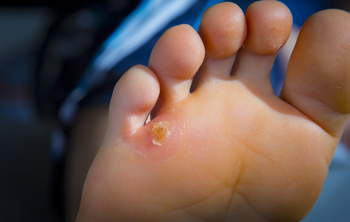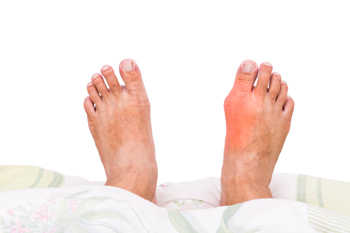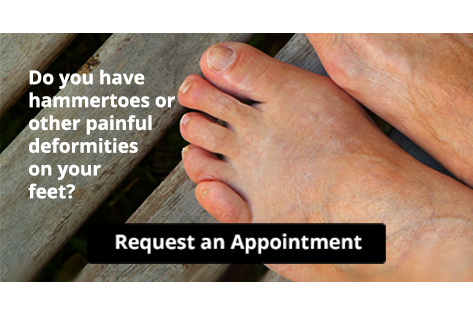Items filtered by date: October 2020
A Common Cause of Corns
 Corns on the feet can be a result of wearing shoes that do not fit correctly. A corn is defined as a small, hardened patch of skin, and can develop on the outside of the pinky toe. Additionally, corns may form between the toes, or on the bottom of the feet. They can cause pain and discomfort, and larger shoes may have to be purchased to accommodate the corn. It is beneficial to try shoes on in the later part of the day when the feet are at their largest. This may help to ensure that shoes fit properly. Relief may be found when a protective pad is worn over the corn, which can alleviate a portion of existing pressure. If you or your child are limping, or complaining about toe pain, please schedule an appointment with a podiatrist who can determine how to properly treat corns on the feet.
Corns on the feet can be a result of wearing shoes that do not fit correctly. A corn is defined as a small, hardened patch of skin, and can develop on the outside of the pinky toe. Additionally, corns may form between the toes, or on the bottom of the feet. They can cause pain and discomfort, and larger shoes may have to be purchased to accommodate the corn. It is beneficial to try shoes on in the later part of the day when the feet are at their largest. This may help to ensure that shoes fit properly. Relief may be found when a protective pad is worn over the corn, which can alleviate a portion of existing pressure. If you or your child are limping, or complaining about toe pain, please schedule an appointment with a podiatrist who can determine how to properly treat corns on the feet.
If you have any concerns regarding your feet and ankles, contact Mark Hupart, DPM of Southside Podiatry . Our doctor will treat your foot and ankle needs.
Corns: What Are They? and How Do You Get Rid of Them?
Corns can be described as areas of the skin that have thickened to the point of becoming painful or irritating. They are often layers and layers of the skin that have become dry and rough, and are normally smaller than calluses.
Ways to Prevent Corns
There are many ways to get rid of painful corns such as wearing:
- Well-fitting socks
- Comfortable shoes that are not tight around your foot
- Shoes that offer support
Treating Corns
Treatment of corns involves removing the dead skin that has built up in the specific area of the foot. Consult with Our doctor to determine the best treatment option for your case of corns.
If you have any questions please feel free to contact our office located in Brooklyn, NY . We offer the newest diagnostic and treatment technologies for all your foot and ankle needs.
Read more about Understanding Corns and CallusesWhat Condition Can a Heel Spur Be Linked To?
 A heel spur is defined as a portion of bone that develops where the plantar fascia connects to the heel bone. It is often linked to the medical condition that is known as plantar fasciitis, which can cause severe pain and discomfort. Mild relief may be found when extra weight is lost and this may ease the pressure on the heel. There are some patients that find it helpful to use shoe inserts, or to wear a night splint. This may alleviate some of the pain that a heel spur can cause. The healing process may be accelerated when the affected foot is rested, and when regular running activities have temporarily stopped. If you have pain in your heel, it is strongly recommended that you consult with a podiatrist who can diagnose and treat this condition.
A heel spur is defined as a portion of bone that develops where the plantar fascia connects to the heel bone. It is often linked to the medical condition that is known as plantar fasciitis, which can cause severe pain and discomfort. Mild relief may be found when extra weight is lost and this may ease the pressure on the heel. There are some patients that find it helpful to use shoe inserts, or to wear a night splint. This may alleviate some of the pain that a heel spur can cause. The healing process may be accelerated when the affected foot is rested, and when regular running activities have temporarily stopped. If you have pain in your heel, it is strongly recommended that you consult with a podiatrist who can diagnose and treat this condition.
Heel spurs can be incredibly painful and sometimes may make you unable to participate in physical activities. To get medical care for your heel spurs, contact Mark Hupart, DPM from Southside Podiatry . Our doctor will do everything possible to treat your condition.
Heels Spurs
Heel spurs are formed by calcium deposits on the back of the foot where the heel is. This can also be caused by small fragments of bone breaking off one section of the foot, attaching onto the back of the foot. Heel spurs can also be bone growth on the back of the foot and may grow in the direction of the arch of the foot.
Older individuals usually suffer from heel spurs and pain sometimes intensifies with age. One of the main condition's spurs are related to is plantar fasciitis.
Pain
The pain associated with spurs is often because of weight placed on the feet. When someone is walking, their entire weight is concentrated on the feet. Bone spurs then have the tendency to affect other bones and tissues around the foot. As the pain continues, the feet will become tender and sensitive over time.
Treatments
There are many ways to treat heel spurs. If one is suffering from heel spurs in conjunction with pain, there are several methods for healing. Medication, surgery, and herbal care are some options.
If you have any questions feel free to contact our office located in Brooklyn, NY . We offer the latest in diagnostic and treatment technology to meet your needs.
Read more about How to Treat Heel SpursDo You Suffer From Painful Feet?
Foot Pain May Coincide With Flat Feet
 Flat feet is a foot condition that is noticeable. It can be detected by standing on the floor and observing that the entire foot lies flat. The arch is not present, and patients can experience dull foot pain. It is often difficult to stand for extended periods of time, and pain may be felt after completing physical activities. It may be beneficial to wear custom-made orthotics, and this can be helpful in reducing existing foot pain. In severe cases, it may be suggested that you undergo physical therapy, which can increase overall foot strength. If you or your child has flat feet, it is strongly suggested that you see a podiatrist who can determine what the best treatments are for you.
Flat feet is a foot condition that is noticeable. It can be detected by standing on the floor and observing that the entire foot lies flat. The arch is not present, and patients can experience dull foot pain. It is often difficult to stand for extended periods of time, and pain may be felt after completing physical activities. It may be beneficial to wear custom-made orthotics, and this can be helpful in reducing existing foot pain. In severe cases, it may be suggested that you undergo physical therapy, which can increase overall foot strength. If you or your child has flat feet, it is strongly suggested that you see a podiatrist who can determine what the best treatments are for you.
Flatfoot is a condition many people suffer from. If you have flat feet, contact Mark Hupart, DPM from Southside Podiatry . Our doctor will treat your foot and ankle needs.
What Are Flat Feet?
Flatfoot is a condition in which the arch of the foot is depressed and the sole of the foot is almost completely in contact with the ground. About 20-30% of the population generally has flat feet because their arches never formed during growth.
Conditions & Problems:
Having flat feet makes it difficult to run or walk because of the stress placed on the ankles.
Alignment – The general alignment of your legs can be disrupted, because the ankles move inward which can cause major discomfort.
Knees – If you have complications with your knees, flat feet can be a contributor to arthritis in that area.
Symptoms
- Pain around the heel or arch area
- Trouble standing on the tip toe
- Swelling around the inside of the ankle
- Flat look to one or both feet
- Having your shoes feel uneven when worn
Treatment
If you are experiencing pain and stress on the foot you may weaken the posterior tibial tendon, which runs around the inside of the ankle.
If you have any questions please feel free to contact our office located in Brooklyn, NY . We offer the newest diagnostic and treatment technologies for all your foot and ankle needs.
Read more about Flat FeetDo I Need Bunion Surgery?
 A bunion is a bony bump that forms along the base of the big toe. Bunions can cause pain and stiffness in the affected foot, as well as swelling. Sometimes surgery, also known as a bunionectomy, may be necessary to correct the deformity and relieve the pain. You may consider bunion surgery if you have severe pain when walking, even when you’re wearing flat comfortable shoes, or when you are unable to bend or straighten the big toe. Other reasons to consider surgery can be chronic inflammation of the big toe that doesn’t go away with rest or medicine, if the big toe becomes deformed, or if the big toe bends towards the smaller toes. A podiatrist can evaluate the severity of your bunion and determine if surgery is the correct method of treatment for you.
A bunion is a bony bump that forms along the base of the big toe. Bunions can cause pain and stiffness in the affected foot, as well as swelling. Sometimes surgery, also known as a bunionectomy, may be necessary to correct the deformity and relieve the pain. You may consider bunion surgery if you have severe pain when walking, even when you’re wearing flat comfortable shoes, or when you are unable to bend or straighten the big toe. Other reasons to consider surgery can be chronic inflammation of the big toe that doesn’t go away with rest or medicine, if the big toe becomes deformed, or if the big toe bends towards the smaller toes. A podiatrist can evaluate the severity of your bunion and determine if surgery is the correct method of treatment for you.
If you are suffering from bunions, contact Mark Hupart, DPM of Southside Podiatry . Our doctor can provide the care you need to keep you pain-free and on your feet.
What Is a Bunion?
A bunion is formed of swollen tissue or an enlargement of boney growth, usually located at the base joint of the toe that connects to the foot. The swelling occurs due to the bones in the big toe shifting inward, which impacts the other toes of the foot. This causes the area around the base of the big toe to become inflamed and painful.
Why Do Bunions Form?
Genetics – Susceptibility to bunions are often hereditary
Stress on the feet – Poorly fitted and uncomfortable footwear that places stress on feet, such as heels, can worsen existing bunions
How Are Bunions Diagnosed?
Doctors often perform two tests – blood tests and x-rays – when trying to diagnose bunions, especially in the early stages of development. Blood tests help determine if the foot pain is being caused by something else, such as arthritis, while x-rays provide a clear picture of your bone structure to your doctor.
How Are Bunions Treated?
- Refrain from wearing heels or similar shoes that cause discomfort
- Select wider shoes that can provide more comfort and reduce pain
- Anti-inflammatory and pain management drugs
- Orthotics or foot inserts
- Surgery
If you have any questions, please feel free to contact our office located in Brooklyn, NY . We offer the newest diagnostic and treatment technologies for all your foot care needs.
Read more about Bunions
